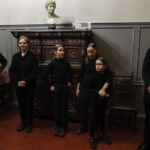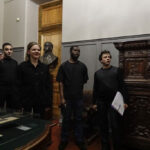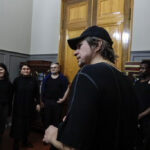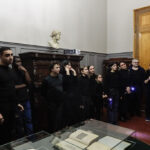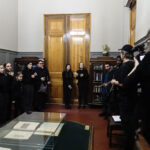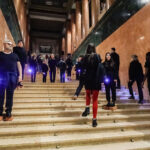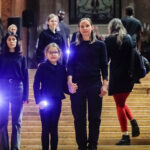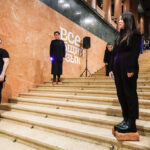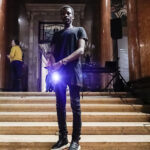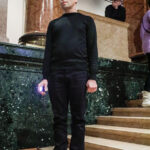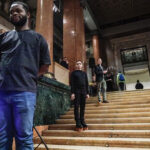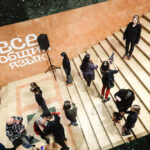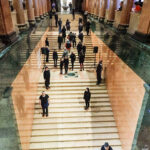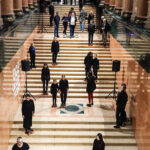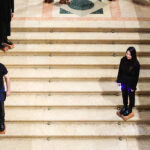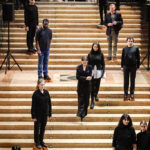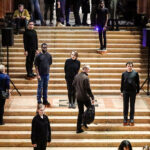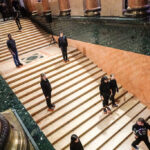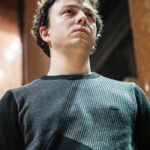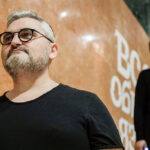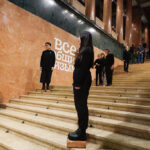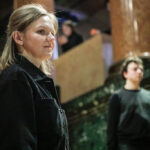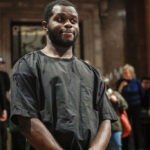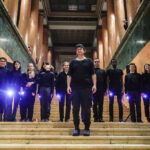Double murder in Segovia
Film by Sergei Katran
This is a mockumentary film, a detective story based on the investigation of a private detective into an unusual find, namely – a male, right index finger of unknown origin. The case takes place in Segovia, Spain, in 2010, on the set of a film with the same name.
The film crew consists of Russian specialists, with a total of 40 people involved in the production. All participants in the film play themselves and recount their stories, developing the details of this incident according to their own discretion, based on the circumstances presented. Naturally, moving from one character to another, the detective obtains new and conflicting information, sometimes coinciding with what someone else has said, and sometimes entirely contradicting it.
The viewer, following the detective, accumulates new facts and details. The film is almost entirely composed of “talking heads” answering the detective’s questions. Moving from one character to another, the detective resembles Odysseus, a traveler who wants to reach a goal, but this goal is not clearly visible; moreover, it flickers, becoming clearer with each new dialogue, only to disappear entirely at times.
The film features a large number of artists from several artistic self-organizations, such as Electrozavod Gallery, Bomba Gallery, F5 (St. Petersburg), Parasites (St. Petersburg), and Transformer Theater.
Duration: 92 minutes 4 seconds.
2023
Sergey Katran / Pupalem scaena
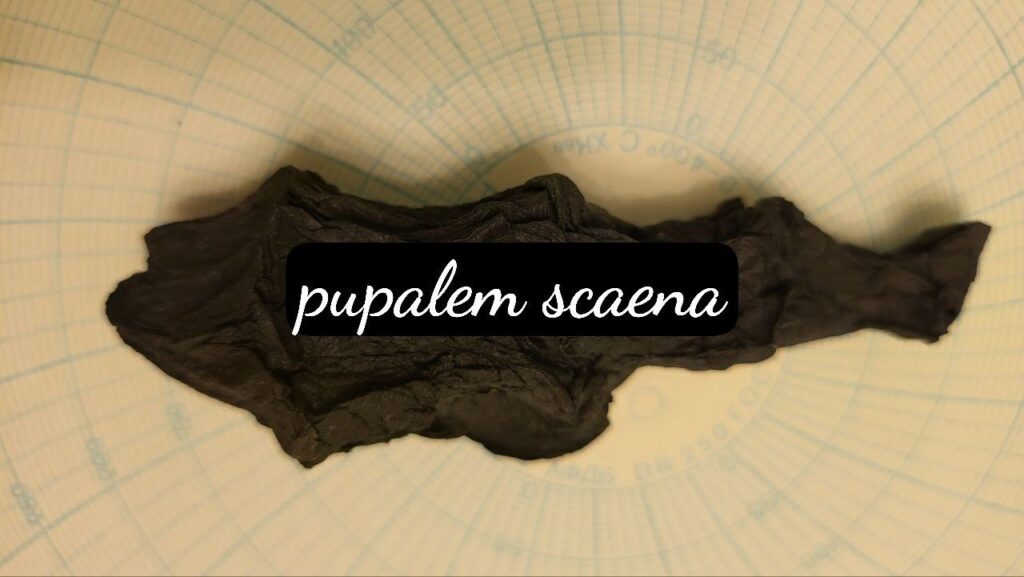
01.12.2023 / opening at 7 pm – 14.01.2024
Moscow, space “This is not here”
Milyutinsky lane, 20/2, building 1
Artist: Sergey Katran
Pupa is the life stage in the development of insects exhibiting complete metamorphosis that occurs between the larval and adult stages (imago). The pupa does not feed and is usually completely motionless or inactive. During pupation, the characteristics of imago develop from imaginal discs and break down larval structures to emerge as adult for the first time.
The Dictionary of Molecular Biology and Genetics
The insect pupa and its subsequent transformation into an adult (imago) is perhaps the best visual metaphor of a person transitioning from one state of consciousness and interaction with the external world to another, thus, acquiring a new identity. This state is associated with the process of undergoing profound personal changes. The metaphor is also applicable to societal changes and transformations. Gregor Samsa, the protagonist of Franz Kafka’s symbolic novella “The Metamorphosis,” turns into a giant insect whilst he experiences an acute sense of alienation and isolation, rejection and disconnection with his family that was increasingly distancing away from him. More than one Kafka’s hero experienced a similar state at the beginning of the last century: owing to the dictate of new demands, the society was undergoing fundamental changes, increasingly preferring the function to the individual, and
technology over a living person. We know what this subsequently led to and what it resulted in the European history.
We do not know how long the new pupal stage will last for us, but we can keep on guessing. We do not see what is inside the pupa, because we are the pupa and cannot observe ourselves in our own entirety. But what is in us is also in the pupa, which means that the outcome of the transformation depends on us. The pupa must be treated with care, just like an adult insect. Had Samsa experienced more loving care in his life, who knows how The Metamorphosis would have turned out? Perhaps alienation, isolation and death would have disappeared altogether…
“I find it extremely difficult to interpret my own work. It is torture. First, you invent a language, create something in it, and then you need to translate from this supposedly universal language into an accessible one. Bingo! And this is what is happening right now: I cannot write anything better and more worthwhile than what Nabokov wrote concerning the subject.”
Sergey Katran
The cradle rocks above an abyss, and common sense tells us that our existence is but a brief crack of light between two eternities of darkness. Although the two are identical twins, man, as a rule, views the prenatal abyss with more calm than the one he is heading for (at some forty-five hundred heartbeats an hour). I know, however, of a young chronophobiac who experienced something like panic when looking for the first time at homemade movies that had been taken a few weeks before his birth. He saw a world that was practically unchanged – the same house, the same people – and then realized that he did not exist there at all and that nobody mourned his absence.
[…] But what particularly frightened him was the sight of a brand-new baby carriage standing there on the porch, with the smug, encroaching air of a coffin; even that was empty, as if, in the reverse course of events, his very bones had disintegrated. Thus, as a boy, I discovered in nature the nonutilitarian delights that I sought in art. Both were a form of magic, both were a game of intricate enchantment and deception… I have ransacked my oldest dreams for keys and clues – and let me say at once that I reject completely the vulgar, shabby, fundamentally medieval world of Freud, with its crankish quest for sexual symbols (something like searching for Baconian acrostics in Shakespeare’s works) and its bitter little embryos, spying, from their natural nooks, upon the love life of their parents.
The compilation of quotations from Vladimir Nabokov’s Speak, Memory
Le Domaine du Bourrian lance l’installation «Avant que le verbe ne disparaisse» de l’artiste Sergei Katran
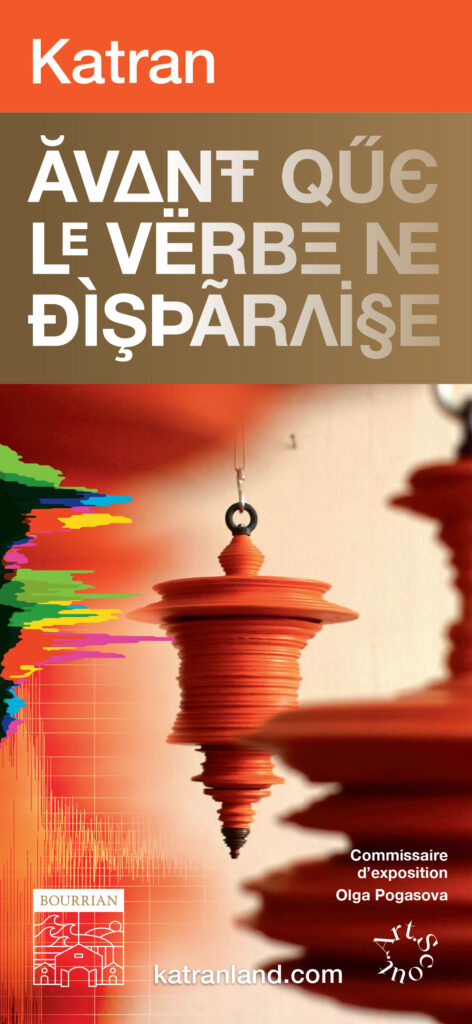
Le vignoble du Domaine Du Bourrian, où je présente mon projet ‘Jusqu’à ce que le mot disparaisse’, me frappe par son authenticité. La vigne, le vin, le bon vieux Midi français ensoleillé, avec l’exubérance de Saint-Tropez, respirent la sérénité et la paix.
En discutant de mon projet avec des amis, je n’ai cessé de penser aux projets artistiques VR/AR de plus en plus dépouillés de leur matérialité. Cependant, j’aime les méthodes de la sculpture classique qui travaillent avec les idiosyncrasies des matériaux d’origine.
Pendant ce temps, l’objet matériel semble devenir obsolète, une chose du passé. Je ne suis ni hypocrite ni fermé d’esprit, je reste ouvert à toutes les nouveautés. Ne vous méprenez pas, je crée aussi des sculptures en RV. Pourtant, j’éprouve une certaine nostalgie pour l’objet matériel. Pendant longtemps, une idée a germé dans mon esprit, jusqu’à ce que je réalise que mon rêve était de représenter le mot en tant qu’objet matériel.
Et j’ai finalement réussi à faire de ce rêve une réalité.
Dans la civilisation humaine, le mot est toujours resté abstrait en tant que son ou symbole, deux substances immatérielles et virtuelles. D’une manière ou d’une autre, j’ai réussi à donner corps au mot, à le libérer de sa coquille virtuelle et à lui faire prendre forme dans l’argile rouge.
La poterie en terre cuite a accompagné la civilisation humaine depuis ses débuts, signalant ainsi son existence. Il était important pour moi de boucler l’histoire de l’art de cette manière, afin de démontrer les possibilités de l’art authentique basé sur l’objet aujourd’hui.
Il y a un deuxième aspect à ce projet. Il est apparu lorsque je me suis plongé dans la richesse et la diversité linguistiques des cultures et des peuples du monde entier. À côté de langues originales incroyablement belles et poétiques, il existe un nombre impressionnant de langues en détresse, proches de l’extinction totale. Il s’agit de multiples langues du Nord de l’Europe, des langues ndei des États-Unis, des peuples d’Afrique, des petits peuples insulaires et de bien d’autres encore. La mondialisation, les guerres, les cataclysmes écologiques, l’expansion des grandes villes modifient la carte anthropologique du monde.
À côté de langues originales incroyablement belles et poétiques, il existe un nombre impressionnant de langues en détresse, proches de l’extinction totale. Il s’agit de multiples langues du Nord de l’Europe, des langues ndei des États-Unis, des peuples d’Afrique, des petits peuples insulaires et de bien d’autres encore.
La mondialisation, les guerres, les cataclysms écologiques, l’expansion des grandes villes modifient la carte anthropologique du monde.
Derrière chaque langue se cache une culture unique et distincte. La préservation de la richesse et de la diversité des langues ne peut être assurée sans modifier le système actuel de priorités politiques, économiques et environnementales.
Domain de Bourrian launches an installation ‘Until the Word is Gone’ by the artist Sergei Katran
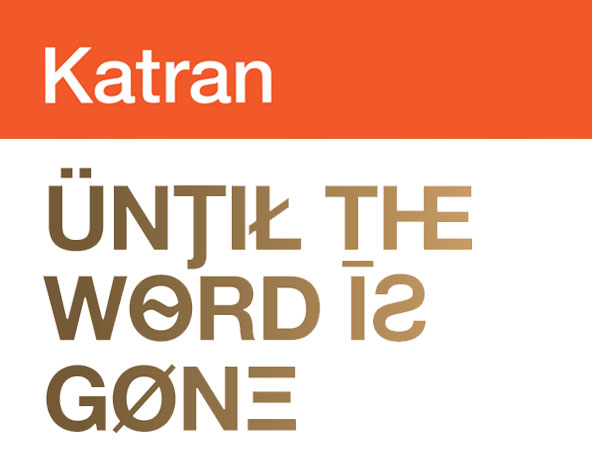
The vineyards of Domain De Bourrian, where I showcase my project ‘Until the Word is Gone’, strike me with the air of authenticity. Vineyards, wine, good old sun-drenched French Midi, with its Saint-Tropez exuberance, breathe serenity and peace.
As I discussed my project with friends, I kept thinking of VR/AR art projects increasingly divested of materiality. However, I love the methods of classical sculpture which works with idiosyncrasies of the original materials.
Meanwhile, the material object seems to grow obsolete, a thing of the past. I am not a hypocrite or bigot, I keep my mind open to all things new. Do not get me wrong, I also create VR sculptures. And yet, I experience a certain nostalgia for the material object. For a long time, an idea kept languishing in my mind, until I realized that my dream was to represent the word as a material object.
And I finally managed to make this dream a reality.
In human civilisation, the word has always remained abstract as sound or symbol — both immaterial, virtual substances. Somehow I managed to em-body the word, release it from its virtual shell, and made it take shape in red clay.
Terracotta pottery has accompained human civlisation from its very inception, thus signalling of its existence. It was important for me to loop the history of art in such a way, so as to demonstrate the possibilities of the authentic object-driven art today.
There is a second aspect to this project. It appeared when I immersed myself in the linguistic richness and diversity of cultures and peoples across the globe. Along with incredibly beautiful, poetic original languages, there exists an overwhelming amount of languages in distress, nearing the state of complete extinction. These are multiple languages of the European North, the Ndei languages of the USA, and of the peoples of Africa, small island peoples, and many others. Globalization, wars, ecological cataclysms, expansion of large cities are changing the anthropological map of the world.
Behind each language is a unique, distinctive culture. The preservation of the richness and diversity of languages cannot be ensured without changes in the existing system of priorities – political, economic, and environmental.
Text by Irene Kukota
UNTIL THE WORD IS GONE. PERFORMANCE.
The Pushkin State Museum of Fine Arts (Moscow), Main building, pink staircase.
20.12.2022 19.00 – 19.30
Artist: Sergey Katran
Curator: Evgenia Kiseleva-Afflerbach
Composer: Oleg Makarov
Participants: Elvina Avamilova, Evgenia Antsupova, Asipa Zhumalieva, Noemi Capela, Alexander Kometiani, Arkadi Kotanjian, Alon Lembritsky, Alexandra Limar, Jean Perchet, Louise Perchet, Mathilde Perchet, Kashallah Hassan, Alessio Gini, Alice Nakamura, Fidel Manga Sebastian
Coordinator: Alexey Debabov
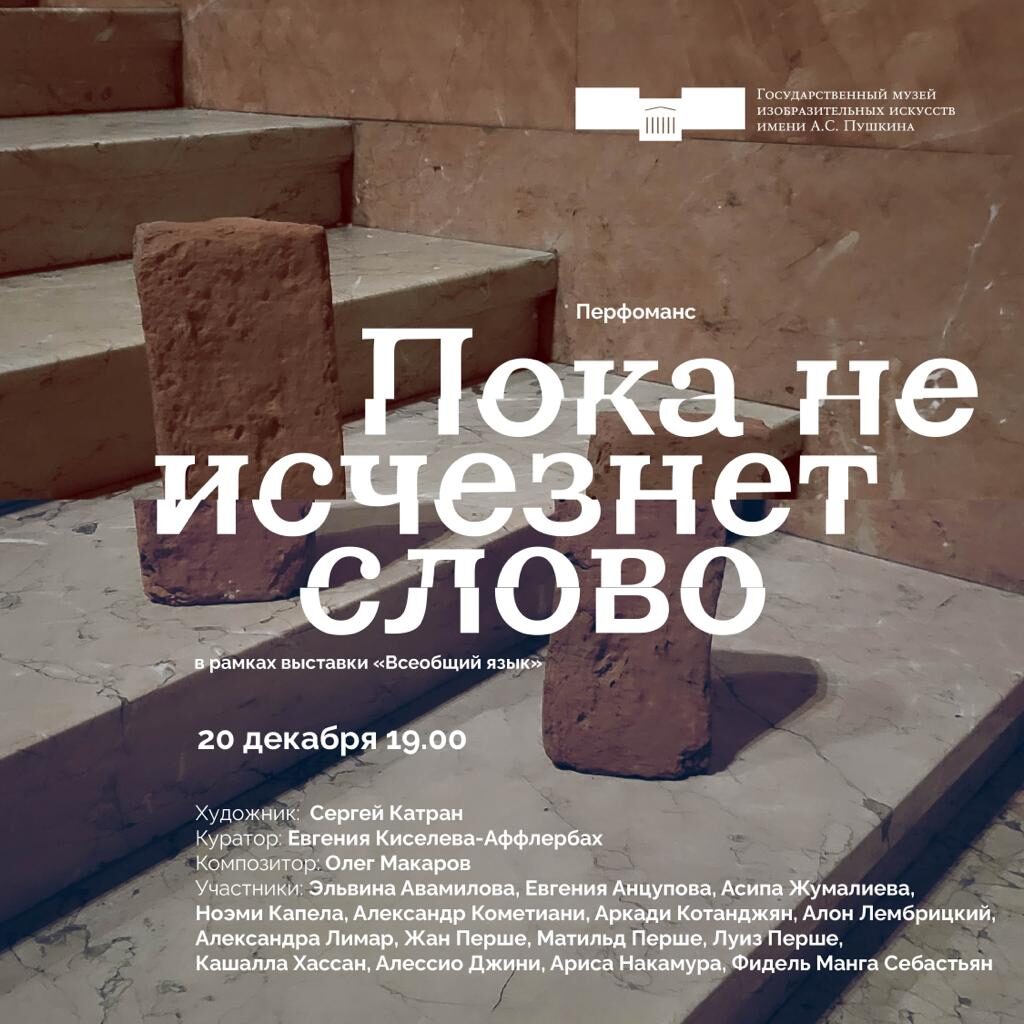
The State Pushkin Museum of Fine Arts presents a site-specific performance by Sergei Katran “Until The Word Is Gone” within the frameworks of its current exhibition “The Universal Language.” On December 20 at 7 pm, visitors to the Pushkin Museum will enter the exhibition through the performative space created by participants who speak different languages. Chuvash, French, Georgian, Arabic, Uzbek, Japanese, Armenian, Italian, Kyrgyz, Hebrew and other languages will resound through the museum’s grand staircase, accompanied by the sound ambience created by the composer Oleg Makarov. This way, they will form a sound corridor leading to the exhibition. The performance integrates the museum space and the soundscape created by the music and voices of native language speakers.
Sergey Katran, artist: “Reminiscent of the facade of a Babylonian ziggurat, the staircase of the Pushkin Museum becomes a symbol and an invitation to reconceptualise the ancient myth and breathe new meanings into it with the help of art. The project is also an attempt to bring a new hope to the visitor, alongside the opportunity to highlight the uniqueness of each language, and of each human life.”
Evgenia Kiseleva-Afflerbach, Head of the Department of Interdisciplinary Projects at the Pushkin Museum: “The human voice is the audible embodiment of the idea of communication. Sergei Katran’s performance at the Pushkin Museum is another opportunity to touch upon the subject of diversity and representation of various people in culture and art. The diversity of the world is more apparent when we can hear a variety of voices.”
The Universal Language exhibition explores the whole range of human interaction and the attempts at finding a common language that recur throughout the centuries. The wealth inherent in multilingualism is demonstrated through the works of art on display, as well as through the manuscripts, handwritten books and other rare objects that encapsulate the history of human communication. And the latter is tested to its limit over the centuries of human history.
Participants of the performance “Until The Word Is Gone” are native speakers of different languages. For some of them, this is their first experience of being part of the creative process, while others are already familiar with performative practices. Only the native speakers of their respective languages were invited to take part. Their voices construct a communicative situation around the Pink Staircase of the Pushkin Museum. The title of the performance Until the Word is Gone is the quintessence of a certain emotional perception of the linguistic diversity across the globe that also belies the fear of losing rare and endangered languages.
The acoustic part of the performance “Until The Word Is Gone” is composed of the sounds of different world cultures. Over the hundred vocal and instrumental fragments of the music originating in various parts of the world among different nations became the building blocks that form the background of this performative project.
Artist: Sergei Katran
Curator: Evgenia Kiseleva-Afflerbach
Composer: Oleg Makarov
Participants: Elvina Avamilova, Evgenia Antsupova, Asipa Zhumalieva, Noemi Capela, Alexander Kometiani, Arkadi Kotanjian, Alon Lembritsky, Alexandra Limar, Jean Perchet, Louise Perchet, Mathilde Perchet, Kashallah Hassan, Alessio Gini, Alice Nakamura, Fidel Manga Sebastian
Translation: Irina Kukota
Coordinator: Alexey Debabov
“Universal Language”. Exhibition
16 DEC 2022 – 19 MAR 2023
Author of the idea: Marina Loshak
Curator group: Tatyana Goryaeva, Alexandra Danilova, Maria Timina
Scientific leadership of the project: Ilya Doronchenkov
“Universal Language”. Exhibition








